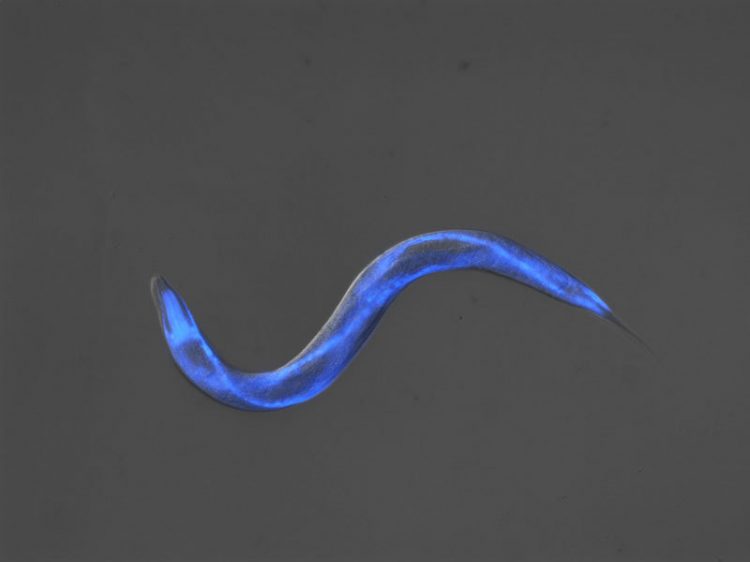How a small worm may help the fight against Alzheimer’s

Image of a C. elegans roundworm. The blue fluorescence highlights the tissue producing most N-acetylglucosamine. © MPI for the Biology of Ageing
Scientists at the Max Planck Institute for Biology of Ageing in Cologne have found that a naturally occurring molecule has the ability to enhance defense mechanisms against neurodegenerative diseases. Feeding this particular metabolite to the small round worm Caenorhabditis elegans, helps clear toxic protein aggregates in the body and extends life span.
During ageing, proteins in the human body tend to aggregate. At a certain point, protein aggregation becomes toxic, overloads the cell, and thus prevents it from maintaining normal function. Damage can occur, particularly in neurons, and may result in neurodegenerative diseases like Alzheimer’s, Parkinson’s or Huntington’s disease.
By studying model organisms like Caenorhabditis elegans, scientists have begun to uncover the mechanisms underlying neurodegeneration, and thus define possible targets for both therapy and prevention of those diseases.
“Although we cannot measure dementia in worms“, explains Martin Denzel of the Max Planck Institute for Biology of Ageing, “we can observe proteins that we also know from human diseases like Alzheimer’s to be toxic by measuring effects on neuromuscular function. This gives us insight into how Alzheimer actually progresses on the molecular level“.
Now, the scientists Martin Denzel, Nadia Storm, and Max Planck Director Adam Antebi have discovered that a substance called N-acetylglucosamine apparently stimulates the body’s own defense mechanism against such toxicity.
This metabolite occurs naturally in the organism. If it is additionally fed to the worm, “we can achieve very dramatic benefits“, says Denzel. „It is a broad-spectrum effect that alleviates protein toxicity in Alzheimer’s, Parkinson’s and Huntington’s disease models in the worm, and it even extends their life span.“
This molecule apparently plays a crucial role in quality control mechanisms that keep the body healthy. It helps the organism to clear toxic levels of protein aggregation, both preventing aggregates from forming and clearing already existing ones.
As a result, onset of paralysis is delayed in models of neurodegeneration – How exactly the molecule achieves this effect is yet to be uncovered. “And we still don’t know whether it also works in higher animals and humans“, says Antebi. “But as we also have these metabolites in our cells, this gives good reason to suspect that similar mechanisms might work in humans.”
Contact
Sabine Dzuck
Max Planck Institute for Biology of Ageing, Köln
Phone: +49 221 37970-304
Fax: +49 221 3797088-304
Media Contact
More Information:
http://www.mpg.de/8009079/roundworm-alzheimersAll latest news from the category: Health and Medicine
This subject area encompasses research and studies in the field of human medicine.
Among the wide-ranging list of topics covered here are anesthesiology, anatomy, surgery, human genetics, hygiene and environmental medicine, internal medicine, neurology, pharmacology, physiology, urology and dental medicine.
Newest articles

Superradiant atoms could push the boundaries of how precisely time can be measured
Superradiant atoms can help us measure time more precisely than ever. In a new study, researchers from the University of Copenhagen present a new method for measuring the time interval,…

Ion thermoelectric conversion devices for near room temperature
The electrode sheet of the thermoelectric device consists of ionic hydrogel, which is sandwiched between the electrodes to form, and the Prussian blue on the electrode undergoes a redox reaction…

Zap Energy achieves 37-million-degree temperatures in a compact device
New publication reports record electron temperatures for a small-scale, sheared-flow-stabilized Z-pinch fusion device. In the nine decades since humans first produced fusion reactions, only a few fusion technologies have demonstrated…





















